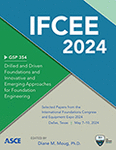Effective Shaking of Bridge Pier on Deep Foundation in Liquefiable Ground
Publication: IFCEE 2024
ABSTRACT
Effective ground shaking is evaluated at the pile cap of a bridge pier by performing kinematic soil-pile interaction analysis, with and without including effects of liquefaction. The subject pier is supported on six 3-m diameter drilled shafts connected by a pile cap, extending through loose liquefiable sand, dense sand, and into bedrock. The computed effective pile cap shaking accounts for the depth-varying free field motions along the pile, and the near field soil-pile interaction, which are both affected by liquefaction. Global bridge modeling in practice typically utilizes soil springs (p-y), which cannot model pore pressure buildup to explicitly simulate liquefaction. To address this limitation, this study aims to bound the pier response by separately considering both liquefied and non-liquefied conditions. Depth-varying free field ground motions are computed at nodal depths along the piles by performing site response analyses, with and without accounting for liquefaction. Separate sets of p-y springs are generated to represent liquefied and non-liquefied soils. The computed depth-varying motions are then used as inputs through the corresponding soil springs to a massless model of the pile foundation. The resulting forces are computed at the pile cap, and the effective motions are then evaluated (referred to as kinematic motions). Response spectra of the kinematic motions are found to be higher for the non-liquefied condition over the period range relevant to the bridge in this study. As a result, the non-liquefied condition would govern seismic demands affecting structural member stresses and sizes. Lower kinematic motions for the liquefied condition are attributed to the softer soils near the mudline, which are not capable of driving the motion of the stiff pile foundation, effectively deepening the pile point of fixity.
Get full access to this chapter
View all available purchase options and get full access to this chapter.
REFERENCES
Abrahamson, N. A. 1998. Non-stationary spectral matching program RSPMATCH, February.
AASHTO. 2017. AASHTO LRFD Bridge Design Specifications, AASHTO, Washington D.C., U.S.A.
Ashford, S. A., Boulanger, R. W., and Brandenberg, S. J. 2011. Recommended Design Practice for Pile Foundations in Laterally Spreading Ground, June.
Caltrans. 2017. Lateral Spreading Analysis for New and Existing Bridges, May.
Caltrans Seismic Advisory Board Ad Hoc Committee on Soil-Foundation-Structure Interaction. 1996., October 24.
Darendeli, M. 2001. Development of a New Family of Normalized Modulus Reduction and Material Damping Curves: Dissertation for Doctor of Philosophy in Civil Engineering at the University of Texas at Austin.
Dickenson, S. E. 1994. Dynamic Response of Soft and Deep Cohesive Soils During the Loma Prieta Earthquake of October 17, 1989: Dissertation for Doctor of Philosophy in Civil Engineering at the University of California at Berkley.
Hashash, Y. M. A., Musgrove, M. I., Harmon, J. A., Ilhan, O., Xing, G., Groholski, D. R., Phillips, C. A., and Park, D. 2020. DEEPSOIL 7.0, User Manual, Urbana, IL, Board of Trustees of University of Illinois at Urbana-Champaign.
Kramer, S. L., and Wang, C. 2015. Empirical model for estimation of the residual strength of liquefied soil. Journal of Geotechnical and Geoenvironmental Engineering 141(9):04015038.
Lam, I. P., and Law, H. 2000. Soil Structure Interaction of Bridges for Seismic Analysis, Multidisciplinary Center for Earthquake Engineering Research.
NASEM (National Academies of Sciences, Engineering, and Medicine). 2021. State of the Art and Practice in the Assessment of Earthquake-Induced Soil Liquefaction and Its Consequences. Washington, DC: The National Academies Press. https://doi.org/10.17226/23474.
PEER (Pacific Earthquake Engineering Research Center). 2014. PEER Ground Motion Database, http://peer.berkeley.edu/peer_ground_motion_database/.
Wilson, P., and Law, H. 2021. Earthquake ground motions for design of bridges on deep foundations, Proc., IFCEE, ASCE, Dallas, Texas.
Youd, T. L., and Carter, B. L. 2005. Influence of soil softening and liquefaction on spectral acceleration, Journal of Geotech. And Geoenv. Eng., ASCE, 131(7), July 1.
Information & Authors
Information
Published In
History
Published online: May 3, 2024
ASCE Technical Topics:
- Continuum mechanics
- Dynamics (solid mechanics)
- Engineering mechanics
- Foundations
- Geomechanics
- Geotechnical engineering
- Geotechnical investigation
- Ground motion
- Hydraulic engineering
- Hydraulic structures
- Kinematics
- Kinetics
- Piers
- Pile foundations
- Piles
- Ports and harbors
- Soil dynamics
- Soil liquefaction
- Soil mechanics
- Soil properties
- Soil-pile interaction
- Solid mechanics
- Water and water resources
Authors
Metrics & Citations
Metrics
Citations
Download citation
If you have the appropriate software installed, you can download article citation data to the citation manager of your choice. Simply select your manager software from the list below and click Download.
